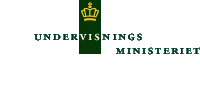
Chapter 2
Education for Sustainable Development in the Baltic Sea Region
The Haga Declaration
By Siv Sellin, Sweden
Following a Swedish initiative, the Ministers of Education of the Baltic 21 countries met in March 2000 at Haga Palace in Stockholm. The purpose of the meeting was to examine the feasibility of creating a network comprising ministries, appropriate authorities and educational institutions dedicated to the implementation of sustainable development through education and training. As a result of the meeting, the Haga Declaration was adopted, which included an agreement to develop an Agenda 21 education programme and the creation of the education sector network with Lithuania and Sweden as lead parties. Agenda 21 for Education should include: definition of goals, review and evaluation of educational activities to promote sustainable development undertaken so far, identification of obstacles and gaps, and an action programme. Three working groups were set up: formal education (schools), higher education and non-formal education.
As a first step in the work, the relationship between environmental education and education for sustainable development was discussed in the working groups. According to the Haga Declaration, education for sustainable development should be based on an integrated approach to economic, environmental and societal development, and encompass a broad range of related issues, such as democracy, gender equity and human rights. This broad approach should be recognised in both natural science and social science, and should complement and build on existing initiatives in environmental education. The difference between environmental education and education for sustainable development was further elaborated in the working group for schools and the result is formulated in table 1:
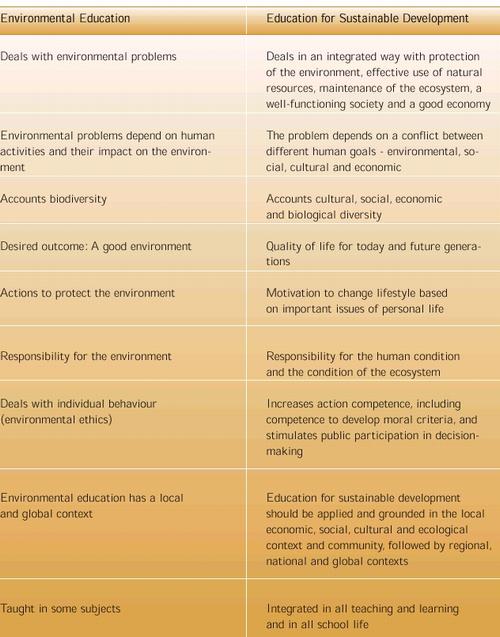
Click on the picture to see the html-version of: ‘‘Environmental Education‘‘
The Haga Declaration also emphasised that education for sustainable development should be pursued at all levels of education and also included in all curricula or equivalent instruments corresponding to the level of education. Such education should be based on broad scientific knowledge and be both integrated into existing disciplines and developed as a special competence. It demands an educational culture directed towards a more integrative process-oriented and dynamic mode emphasising the importance of critical thinking and social learning as well as a democratic process.
Each working group was responsible for conducting surveys of existing practices and provisions. The working group for schools, consisting of one representative from each country in the Baltic Sea Region, formulated a common framework for evaluation. It was seen as important to study the situation in countries with respect to both general and educational goals concerning environmental care and sustainable development. In addition, the way environmental education and education for sustainable development was actually provided in schools with respect to content, organisation and methods was to be studied. In order to identify all obstacles and gaps, questions were asked concerning competence of staff, support, partnerships and materials.
The survey found that a single-subject approach still seems to be most common in school. Scientific knowledge and scientific studies appear to be the most important part of environmental education, and transmitting these facts still seems to be a common method in schools. Among all educators there seems to be a lack of understanding of the concept of sustainable development and particularly knowledge about how to integrate economics and social aspects with the ecological aspects. In many countries, the curriculum design creates obstacles to covering the needs of environmental education/education for sustainable development in regular education.
There are, however, many indications of development towards education for sustainable development. Many methods are being used that could transform educational culture into a more integrative and dynamic mode in line with the Haga Declaration. Being in touch with the real world and building action competence are important components of education for sustainable development. Efforts in many schools to relate theory to practice in making the school environmentally friendly and in working with the local environment are promising examples of such work.
To fill the gaps identified in the survey, an action programme was formulated.
The aim here is to give strong political signals, to develop competence, to stimulate the production of materials, and to initiate and promote research and development.
 Goals Goals
The following goals were formulated for schools:
The individual learner should have the knowledge, values and skills to be an active, democratic and responsible citizen and to participate in decisions at individual, as well as at different levels within society, locally and globally, to contribute to creating a sustainable society. Learners in vocational education should also have skills and competencies relevant to their future professions.
This will require the following:
- Legal provisions that clearly include education for sustainable development
- Incorporation of education for sustainable development in regular teaching and learning activities in school and as the basis of all school life
- Educators with relevant competence to include sustainable development in their teaching
- Suitable learning methods and a learning environment conducive to sustainable development.
The second meeting of Ministers of Education, January 2002
The Ministers of Education from the countries of the Baltic Sea Region, namely Denmark, Estonia, Finland, Germany, Iceland, Latvia, Lithuania, Norway, Poland, Russia and Sweden, met at Haga Palace in Stockholm on 24-25 January 2002 for their second meeting.
The purpose of the meeting was two-fold: to examine the results achieved by the Baltic 21 Education Sector Network and its three working groups in respect of the task given at the first ministerial meeting at Haga Palace in March 2000; and to adopt an Agenda 21 for Education for Sustainable Development in the Baltic Sea Region, Baltic 21E.
At the meeting, the ministers adopted the Agenda 21 for Education in the Baltic Sea Region (Baltic 21E), endorsed the major commitments, goals and action programme contained in Baltic 21E, and resolved to ensure an efficient implementation of Baltic 21E.
The Baltic Sea Project in the implementation of Baltic 21E
Under the joint action area “Research on and development of education for sustainable development”, two actions are formulated in the following way.
- Encourage international co-operation regarding research and development of education for sustainable development, and support and initiate networks for experience sharing and joint activities at all levels
- Stimulate and support different approaches in education covering an interdisciplinary approach, ways of including aspects of sustainable development in different subjects, involving education in a local context, as well as collecting and disseminating examples of good practice
For more than ten years, the Baltic Sea Project has played an active role in stimulating and initiating networks of schools in the Baltic Sea Region. At the same time, development of teaching methods in environmental education and education for sustainable development in line with Baltic 21 has been stimulated and also produced good results. The Baltic Sea Project can therefore be seen as an important actor in spreading good examples and in taking part in the important development work in Baltic 21.

Measuring Progress – Key Elements
By Kaisa Lindström, Finland
To constitute a learning process and development towards active citizenship, the following key elements should be considered:
- Information: Information on opportunities should be given to projects, local problems and other activities that students could work on to learn information techniques as well as enter into dialogue and network with others involved in education for sustainable development. The knowledge achieved should be made widely available and disseminated by different means, such as twinning and networking. Wide sharing of information is also a criterion of democracy.
- Motivation is crucial for all kinds of learning. When a person starts a learning process, motivation largely depends on the expectations of the learner and on the nature of information previously obtained. Inner motivation grows through experience, new interpretations and the usefulness of the knowledge and skills gained.
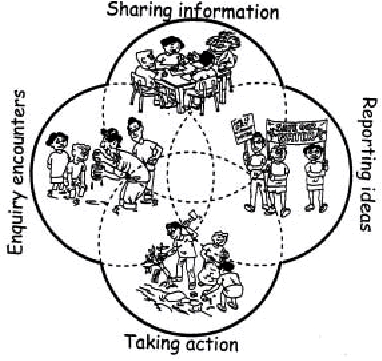
From ”The Long Way to Sustainability” Johannesburg 2002
- Training: The challenge of education for sustainable development is how to show the complex nature of the societies we live in today, how to make ecological, economic, political and technical processes transparent, and how to facilitate a holistic approach to environmental problems.
A reverse chronology of the time perspective is needed: the past the present the future. The present situation, knowledge or problem is always in dialogue with the past and the future. Therefore, historical aspects as well as tools for future research have to be incorporated.
- Learning is a constructive process: The learner constructs knowledge and interprets it according to his/her own former knowledge and according to his/her worldview. Knowledge can be fully understood only when it is used. Personal experiences have a strong effect on the whole learning process.
- Cultural activities can be linked to aesthetic education for sustainable development; they enhance appreciation of one’s cultural heritage and teach practical and traditional skills. At the same time, cultural activities build a platform for learning to understand other cultures.
- Competence development is crucial for putting theories into practice. The challenge for learners is to commit themselves to competence development and to the learning process. A learner needs competence (theory, skills) in order to proceed with the learning process, gaining more competence in the process.
- Projects are practical working environments in education for sustainable development. Projects include networking, an authentic situation and competence development. Projects can be large, involving many partners, or small-scale ventures geared to influencing concrete conditions or to addressing a local problem. Projects with partner schools in the Baltic Sea Region expand the learning environment on education for sustainable development, which leads towards international co-operation and cultural understanding.
- Availability is an essential element. Local networks and local action groups provide a context for the personal learning process, a platform for working together and an opportunity to be part of a social network. Partnerships between companies, educational institutions and non-governmental organisations should be promoted. The Internet and virtual, open and distance learning environments offer a wide range of new opportunities for acting in a global network.
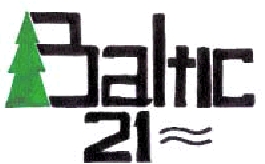
Maria
Mensonen, Finland
Suggested Methods for Self-evaluation (Indicators)
By Kaisa Lindström, Finland Schools are recommended to make an annual evaluation and discuss in a transparent and democratic way:
- What has actually happened? What have we done, experienced and achieved?
- What can we learn from our experience?
- How can we better distinguish between our sphere of interest and our sphere of influence?
- How can we be more proactive?
- What actions should we take in the coming year?
- How should we adjust our vision?
- What are our goals for the coming year?
 2.1 Evaluation model of the process of change in attitudes: 2.1 Evaluation model of the process of change in attitudes:
This model can be used at three levels: the personal, the team or the organisation level. Discussion regarding the phases where individuals, teams or organisations are placed in this process will serve as a tool for evalua-tion.The commitment to education for sustainable development can only grow through the reflective and interactive process of individuals and communities.
Step 1 Think that the individual, the team or the organisation knows the main things about education for sustainable development
Step 2 Know that person, the team or organisation does not know enough about education for sustainable development
Step 3 Know about education for sustainable development
Step 4 Understand sustainable development
Step 5 Put knowledge into practice
Step 6 Develop new models and innovations to promote education for sustainable development
The following checklist may serve as a tool and can be further elaborated locally
-
Information
Does the school/organisation have a document, e.g. an action plan, a school policy, a set of values etc, which provides a framework for implementing education for sustainable development? Is it written in a language and style which everyone in the school can understand?
Quantity becomes quality: What kind of information is available and how many articles, brochures, course descriptions have been used? How are the goals formulated?
- Motivation
Initially, motivation comes from the information and knowledge that the learner has, or through the perception of problems, needs or events. Later, the usefulness of newly-acquired knowledge and skills maintains the motivation. The criteria here are quality of information and linkage between theory and practice.
Changes in attitudes – criteria become visible in action. Awareness of and responsibility for promoting sustainable development are closely linked to competence and opportunities to influence conditions.
- Training
How do the key elements and the overall goals become visible through training?
Is access equal for all? What methods are used in training? Are people committed to promoting education for sustainable development?
- Learning
Do we have open learning environments? Do we have a holistic approach?
Is there interaction?
Do we manage creative learning?
- Cultural activities
Do the school culture and ethics promote education for sustainable development?
Do the creative subjects, such as arts, crafts and design play a role in promoting sustainable development?
What aesthetic view is presented in education for sustainable development?
Does education for sustainable development deal with the multicultural aspect?
Is education for sustainable development a tool for strengthening identity?
Does education for sustainable development require co-operation and networking skills?
- Competence development
How many authentic situations and opportunities are there for showing the competence gained?
Are communicative and social competences elements of the competence development? How many innovations are there in day-to-day operations and in education, teaching methods, learning materials and co-operation? Does education for sustainable development include and develop problem-solving skills? Competence development is not valuable in itself, but becomes so in actions and interactions, and in authentic situations where a person is able to use the action competence acquired.
- Projects
How can projects be designed to take the goals of education for sustainable development into consideration?
How can projects be evaluated in terms of achieving development goals?
- Opportunities
How many opportunities are there for education for sustainable development? What is the quality of these opportunities?
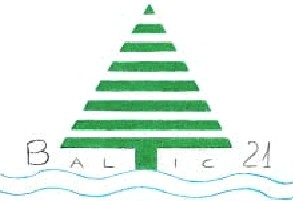
Mára Alksne, Latvia
Environmental History and the Time Dimension
By Per Eliasson, Sweden
How do you heat your house? How is food produced on the farms in your neighbourhood? How have the landscapes – forests, fields and waters - changed during the last one hundred years?
The answer to these questions will probably be that your house has been heated by oil and/or coal, and that farms produce food using a high input of artificial fertiliser and machinery driven by diesel oil. The landscape was much more diversified a hundred years ago – i.e. there were different species of tree, smaller fields, and many small ponds and watercourses everywhere.
If you want to know in what direction you are going, you need knowledge of at least two points: a point in the past and a point in the present. Only then can you have a fair idea of where you will be in the future. We therefore need a knowledge of the past to have some reasonable idea of the future.
How can the historical perspective be used in environmental work?
Since the economic development of Europe
and America has become the blueprint for developing countries such as India and China, the problems of global pollution and resource depletion will continue. The economic development of Europe and America has been based on an industrialisation where the use of cheap fossil fuels has increased exponentially.
The motivation for the poor countries to adopt a new strategy for economic development, while the rich countries at the same time cling on to their old strategy of ever-increasing resource use, is weak. When the USA, which is responsible for 25% of the world’s oil consumption, refuses to discuss international limitations for the use of fossil fuels, it sets a bad example to other countries.
In order to understand the degree of the changes needed, we must look back and ask how this strategy of ever-increasing usage of resources was introduced. This is best done through local environmental history studies. When did our city start using coal and oil for heating, for production and for transport? Why did this happen? What were the consequences?
Learning from the past for the decisions of the future

Always use a timeline in environmental history
How was food produced on our farms before the arrival of industrialisation? How was nutrition used? When were fertilisers introduced, and what were the consequences?
How is the use of fertilisers and fossil fuels in our agriculture connected to industrialisation? What happened to the diversity of landscapes when these new methods were introduced? Why?
When we have the answers to these questions, it will be possible to discuss what we think of the future. Then we can also link our conclusions to the global situation. Is this a sustainable development for the whole world? If not, what changes are necessary here in our local community? What would the consequences be?
In this way, environmental history can contribute to an analysis of sustainable development on both a local and global scale.
 Ideals of environmental history studies conducted by students Ideals of environmental history studies conducted by students
Students working with environmental history:
- start from environmental problems of today - they do not study the past independently of the present
- have a perspective of the future - they are not satisfied only with a better understanding of the present situation but want to create action competence for the future
- can accomplish practical results - they do not use their results only inside the school but present them to the community in order to change the situation
- use chronology as an important tool both in explanations and in narratives - they therefore avoid looking at questions as "eternal"
- start from conflicts about the environment - they thereby avoid both a biased natural science and a moralistic perspective
- look at active actors in history - they are therefore not satisfied with structural explanations but seek the causes behind people‘s actions
- start with studies of the local environment in order to draw conclusions about other areas from their results - they do not start with the great trends in world history in order to illustrate this on a local level

Denne side indgår i publikationen "EDUCATION FOR SUSTAINABLE DEVELOPMENT" som kapitel 2 af 8
© Undervisningsministeriet 2003
|